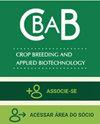The use of high-throughput phenotyping in genomic selection context
IF 1.5
4区 农林科学
Q2 Agricultural and Biological Sciences
引用次数: 3
Abstract
One of the biggest challenges that breeders face is the development of improved cultivars in changing climate conditions posing extra challenges to their labor. On the other hand, the availability of data generated with automated systems offers an opportunity to characterize genetically and phenotypically genotypes with high detail. Modern sequencing technologies delivering hundreds of thousands of molecular makers, offered the opportunity of selecting genotypes without the need of observing these in fields and this methodology was coined as Genomic Selection (GS). More recently, sophisticated automated phenotyping platforms depending on sensors able to measure a large number of plant features were also developed and have shown potential in plant breeding applications. These modern phenotyping systems that attempt to efficiently deliver phenotypic information on secondary traits are also know as high-throughput phenotyping platforms (HTPPs). The integration of HTPP with GS models opened a new research front to improve the efficiency of the selection methods based on genomic data only, specially of those traits depending on a large number of genes with small effects (complex traits). However, there are still remaining some issues to solve for developing a robust methodology able to combine in an efficient and informed way these two high dimensional data types. In this document, we provide an overview of the statistical analysis of the data derived of the HTTPs for improving the predictive ability of conventional GS models. First, we provide a brief introduction showing the utility of genomic data in plant breeding applications. Then, we provide an overview of the field-based HTPPs considering the light detection and ranging, and the unmanned aerial vehicles and how the image data derived from these platforms can be used to accelerate genetic gains. After that, we discuss about the extension of the conventional GS models to allow the incorporation of data derived of the HTPPs as main effects and also in interaction with environmental factors. The availability of several sources of information have opened a venue to investigate besides the univariate or single trait model, models based on multiple traits and also models that consider multiple time measures allowing longitudinal GS studies. Finally, we provide some conclusions as well as we mention some the current issues that do not allow to fully exploit the potential of HTTPs in plant breeding applications.高通量表型在基因组选择中的应用
育种人员面临的最大挑战之一是在不断变化的气候条件下开发改良品种,这给他们的劳动带来了额外的挑战。另一方面,自动化系统生成的数据的可用性提供了一个机会,可以非常详细地表征遗传和表型基因型。现代测序技术提供了成千上万的分子制造者,提供了选择基因型的机会,而不需要在野外观察这些基因型,这种方法被称为基因组选择(GS)。最近,依赖于能够测量大量植物特征的传感器的复杂自动化表型平台也被开发出来,并在植物育种应用中显示出潜力。这些试图有效地传递二级性状表型信息的现代表型系统也被称为高通量表型平台(HTPPs)。HTPP与GS模型的结合,为提高仅基于基因组数据的选择方法的效率,特别是对那些依赖大量基因而影响较小的性状(复杂性状)的选择效率开辟了新的研究前沿。然而,要开发一种健壮的方法,能够以有效和明智的方式组合这两种高维数据类型,仍然需要解决一些问题。本文综述了对HTTPs数据的统计分析,以提高常规GS模型的预测能力。首先,我们简要介绍了基因组数据在植物育种中的应用。然后,我们概述了基于现场的htpp,考虑到光探测和测距,以及无人机,以及如何使用来自这些平台的图像数据来加速遗传增益。在此之后,我们讨论了传统GS模型的扩展,以允许纳入HTPPs的数据作为主要影响以及与环境因素的相互作用。除了单变量或单性状模型,基于多性状的模型以及考虑允许纵向GS研究的多时间测量的模型之外,一些信息来源的可用性为研究开辟了一个场所。最后,我们提出了一些结论,并指出了目前还不能充分利用HTTPs在植物育种应用中的潜力的一些问题。
本文章由计算机程序翻译,如有差异,请以英文原文为准。
求助全文
约1分钟内获得全文
求助全文
来源期刊
CiteScore
2.40
自引率
13.30%
发文量
25
审稿时长
6-12 weeks
期刊介绍:
The CBAB – CROP BREEDING AND APPLIED BIOTECHNOLOGY (ISSN 1984-7033) – is the official quarterly journal of the Brazilian Society of Plant Breeding, abbreviated CROP BREED APPL BIOTECHNOL.
It publishes original scientific articles, which contribute to the scientific and technological development of plant breeding and agriculture. Articles should be to do with basic and applied research on improvement of perennial and annual plants, within the fields of genetics, conservation of germplasm, biotechnology, genomics, cytogenetics, experimental statistics, seeds, food quality, biotic and abiotic stress, and correlated areas. The article must be unpublished. Simultaneous submitting to another periodical is ruled out. Authors are held solely responsible for the opinions and ideas expressed, which do not necessarily reflect the view of the Editorial board. However, the Editorial board reserves the right to suggest or ask for any modifications required. The journal adopts the Ithenticate software for identification of plagiarism. Complete or partial reproduction of articles is permitted, provided the source is cited. All content of the journal, except where identified, is licensed under a Creative Commons attribution-type BY. All articles are published free of charge. This is an open access journal.

 求助内容:
求助内容: 应助结果提醒方式:
应助结果提醒方式:


